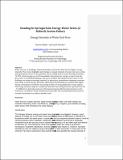| dc.contributor.author | Siddiqi, Afreen | |
| dc.contributor.author | Fletcher, Sarah Marie | |
| dc.date.accessioned | 2016-06-17T21:47:31Z | |
| dc.date.available | 2016-06-17T21:47:31Z | |
| dc.date.issued | 2015-02 | |
| dc.identifier.issn | 2196-3010 | |
| dc.identifier.uri | http://hdl.handle.net/1721.1/103154 | |
| dc.description.abstract | Water end-use, in buildings, industrial facilities, and farms, often has the highest energy intensity. This review highlights key findings on energy intensity of water end-use in urban and agricultural sectors. In the domestic sector, energy used for water heating constitutes 14–25 % of total energy use in US households. Heat pumps for energy recovery from hot grey water in residential buildings, and micro-turbines operating from grey water in tall buildings, are being increasingly explored. In agriculture, groundwater pumping consumes most of the on-farm energy, and water-efficient pressurized delivery systems have higher energy consumption. Rainwater harvesting systems are being deployed in many regions. The energy intensity range for residential rainwater harvesting has been reported to be 0.6–5.3 kWh/m[superscript 3] in Australia. However, with improved pump efficiency, the intensity can be lowered to 1.5 kWh/m[superscript 3], which would be less than other non-conventional sources such as seawater desalination or indirect potable reuse. | en_US |
| dc.publisher | Springer International Publishing | en_US |
| dc.relation.isversionof | http://dx.doi.org/10.1007/s40518-014-0024-3 | en_US |
| dc.rights | Article is made available in accordance with the publisher's policy and may be subject to US copyright law. Please refer to the publisher's site for terms of use. | en_US |
| dc.source | Springer International Publishing | en_US |
| dc.title | Energy Intensity of Water End-Uses | en_US |
| dc.type | Article | en_US |
| dc.identifier.citation | Siddiqi, Afreen, and Sarah Fletcher. “Energy Intensity of Water End-Uses.” Curr Sustainable Renewable Energy Rep 2, no. 1 (February 10, 2015): 25–31. | en_US |
| dc.contributor.department | Massachusetts Institute of Technology. Institute for Data, Systems, and Society | en_US |
| dc.contributor.department | Massachusetts Institute of Technology. Engineering Systems Division | en_US |
| dc.contributor.mitauthor | Fletcher, Sarah Marie | en_US |
| dc.contributor.mitauthor | Siddiqi, Afreen | en_US |
| dc.relation.journal | Current Sustainable/Renewable Energy Reports | en_US |
| dc.eprint.version | Author's final manuscript | en_US |
| dc.type.uri | http://purl.org/eprint/type/JournalArticle | en_US |
| eprint.status | http://purl.org/eprint/status/PeerReviewed | en_US |
| dc.date.updated | 2016-05-23T12:12:53Z | |
| dc.language.rfc3066 | en | |
| dc.rights.holder | Springer International Publishing AG | |
| dspace.orderedauthors | Siddiqi, Afreen; Fletcher, Sarah | en_US |
| dspace.embargo.terms | N | en |
| dc.identifier.orcid | https://orcid.org/0000-0003-3289-2237 | |
| mit.license | PUBLISHER_POLICY | en_US |
| mit.metadata.status | Complete | |
